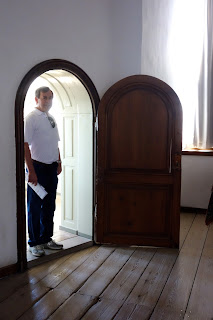We can learn so much from studying historic buildings about classic rules for exterior and interior design. Denmark has lots of old buildings well-worth analyzing for practical design tips.
For example, this historic stone doctor's office in The Funen Village in Odense, Denmark can offer guidance to today's homeowners struggling with exterior paint and roof color choices.
The colorist's principle used for this stone building was: When choosing paint colors for a stone or brick home, match the chinking for the largest percentage of non-stone surface and choose a complimentary color for the details. Notice how the red-brown color on the door and roof framing is drawn from the stones themselves?The thatched roof also matches the stone. Traditionally, roofing was made of natural materials--straw, wood, or slate. Consequently, even today you can never go wrong choosing gray-brown or gray-black tones for roofing.
What about this half-timbered house in Odense? How does the paint selection help emphasize the wood and downplay the stucco?
The darker colors draw the eye to the decorative timber while the stucco's neutral color remains in the background.
As far back as the 17th century European barns were painted red. Supposedly, this was because farmers used a mixture of linseed oil, milk, lime, and ferrous oxide to kill fungi and moss and seal the wood from decay. Apparently, the mixture left the barns reddish in color. When the European farmers immigrated to the United States they brought their barn color-of-choice with them.
Now, when choosing colors, homeowners should rely on the classics--like red for barns, slate gray or shingle brown for roofs, white for clapboard. These expected colors won't hinder a sale of a home the way a blue roof would.
The Danes make an exception from choosing classic paint colors in their row houses. Caution: I wouldn't follow their use of bright pastel colors when choosing your home's exterior--unless you live in Seaside, Florida. :)
Now, let's look into some Danish castles and palaces for tips on interior architectural details.
Floors in these historic buildings get special treatments.
An octagonal room calls for flooring to follow the shape, but note how the horizontal boards highlight the pie shape.
A rectangular room receives a rectangular pattern.
Texture on ceiling and pattern on floor make this hall an interesting gallery. The plain white walls and textured, but monochromatic, ceiling allow the floors to take center stage.
In contrast, in this room, the tapestry walls compete with the pattern on floor. If the floor pattern was a smaller-scale and monochromatic, it would have faded into the background, and the tapestry-covered walls would have been the uncontested focal point. As it is, they clash. I guess we can learn from mistakes made in the past, as well as from their successes.
All we have to do is look up to find more pointers in these historic structures. For the past several years, designers have been urging us to make our ceilings interesting. It seems that we are late to the game.
Look at this masterpiece...
and at this baroque ceiling!
Doorways are another often forgotten element in our home design. The Danes were not guilty of overlooking the impact a door can make.
This door draws you in by its shape and size.
I hope you enjoyed the things I noted on our tour in Denmark. My next post, I will take you on a tour of Denmark's capital.























0 comments :
Post a Comment